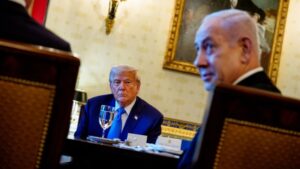In a recent statement, former President Donald Trump suggested that the popular social media platform TikTok could potentially be acquired by a newly proposed U.S. sovereign wealth fund. This remark came amid increasing pressure for TikTok to secure new ownership by a specified deadline in April. Trump’s announcement highlighted his plans to ensure the app continues operating in the United States while mitigating concerns regarding data privacy, particularly in regard to its current ownership by the China-based parent company, ByteDance.
During the announcement, Trump indicated that the specifics surrounding this acquisition plan were still vague. He confirmed that TikTok could be “put in” the sovereign wealth fund, aiming to safeguard the access of the app for its 170 million American users. His comments included a comparison to other nations, stating, “Other countries have sovereign wealth funds,” as he signed an executive order to establish such a fund in the United States. This initiative was modeled after existing state-owned investment funds in various nations, like Norway and Saudi Arabia, which effectively channel national budgets into various financial assets, including stocks, bonds, and real estate.
Expanding on the matter, Trump remarked on the numerous possibilities regarding TikTok’s future. He indicated that if an appropriate deal could be negotiated, the app would be included within the sovereign wealth fund or possibly developed through partnerships with wealthy investors. However, the timeline for setting up such a fund seems short, as the deadline for TikTok’s ownership resolution draws near. Under the current legal framework, the app is required to either divest from ByteDance or face a potential ban in the United States.
Despite promising to facilitate a deal to maintain TikTok’s presence in the country, concerns arise as to the feasibility of this acquisition model. Establishing a sovereign wealth fund capable of financing the acquisition could take substantial time, and questions linger surrounding who would oversee the fund and how the required significant capital could be generated to purchase TikTok. There’s also growing apprehension about the implications of a governmental acquisition, particularly concerning its management, which could complicate governance due to First Amendment protections.
Alan Rozenshtein, a legal expert from the University of Minnesota, described the structural requirements needed to ensure that any divestment from ByteDance meets congressional concerns. For a potential deal to align with the existing sell-or-ban law signed by former President Joe Biden, ByteDance would need to limit its stake in TikTok to no more than 20%, and there would have to be a clear separation between the operations of the two entities. Additionally, full control of TikTok’s algorithm would need to be relinquished by ByteDance, a demand that could involve resistance from both the company and Chinese authorities.
On the other hand, the implications of a U.S. government ownership of TikTok pose challenging questions regarding user privacy and content management. Many users expressed skepticism and concern on social media platforms, questioning the motivations of the government in seizing ownership and fearing censorship or manipulation of content. Comments about the dystopian implications of government control over social media were prevalent, indicating strong public sentiment against the idea of government-monitored social media platforms.
As the situation develops, the potential acquisition raises both legal and ethical concerns that lawmakers, tech experts, and users alike are keenly analyzing. Should TikTok’s ownership transition to a sovereign wealth fund or any form of governmental structure, the resulting stability, user trust, and operational viability of the application in a fast-paced digital environment would greatly hinge on these intricate considerations. The ongoing discourse reflects broader societal concerns regarding privacy, freedom of expression, and the appropriate role of government in regulating digital spaces. Thus, the road ahead presents significant challenges and uncertainties for all stakeholders involved.











